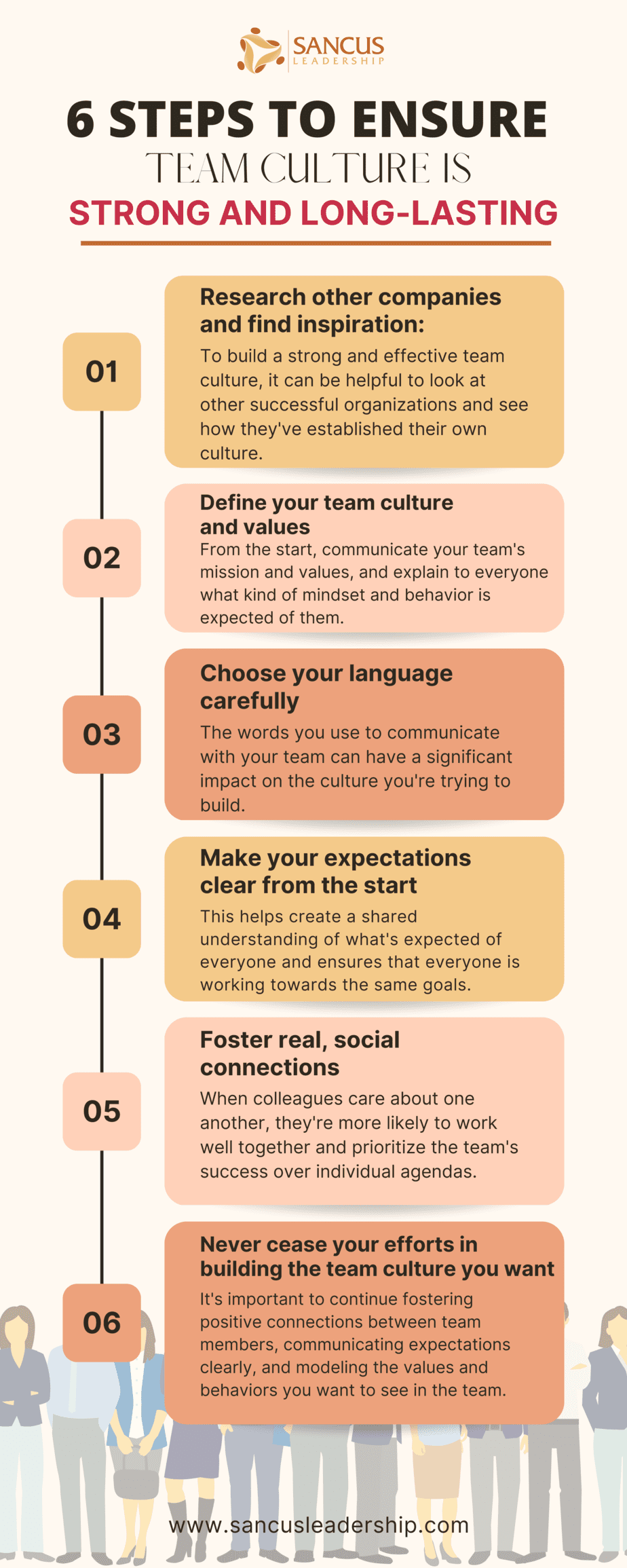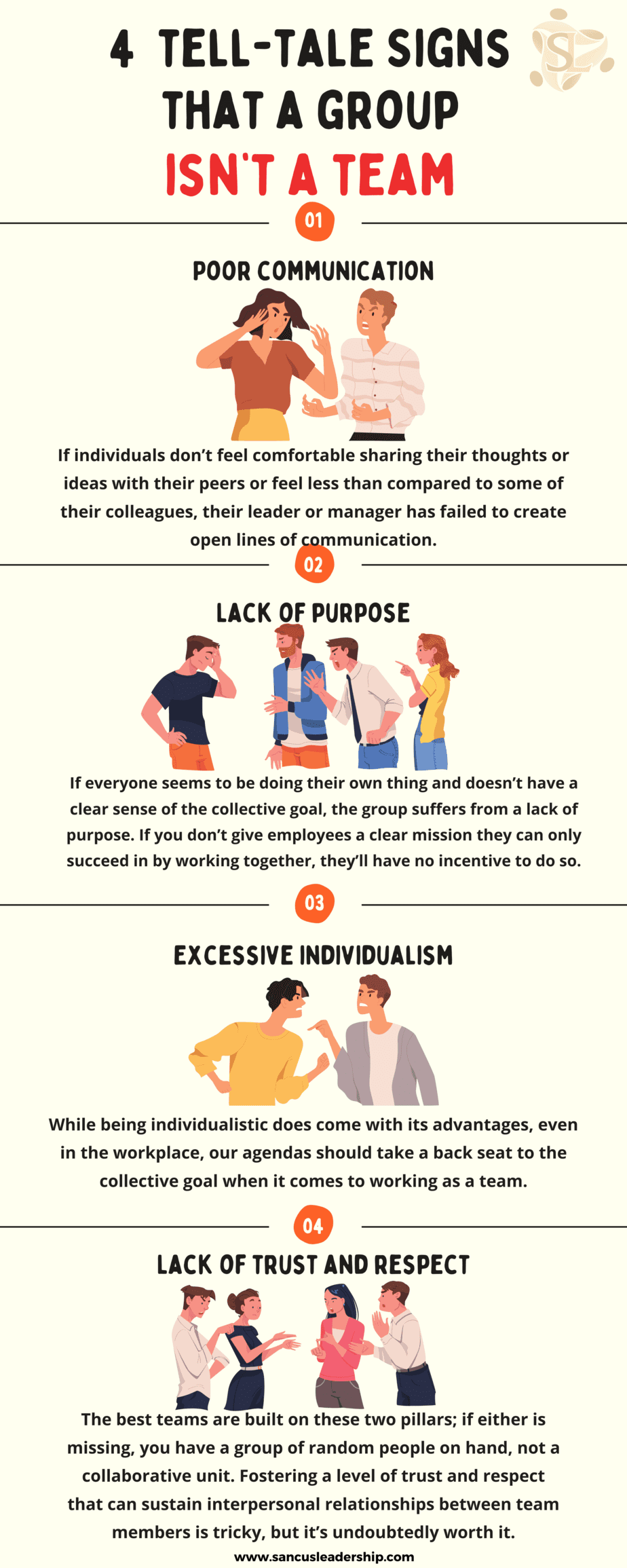Spending thirteen years as an officer in the Army has made me take some things for granted. One is that only some understand the vital difference between a team and a group of people. That not just any group of people thrown together makes a team. A true team works as a single body, mastering individual communication and coordination. Even though building a team out of a group of people comes with a wide array of challenges and obstacles, it’s still one of the most rewarding processes I have ever experienced – so how can you go about it?
Building a team out of a group of people involves identifying each team member’s strengths and weaknesses, setting clear goals, assigning roles, fostering open and honest communication, encouraging teamwork, celebrating successes, and leading by example.
How team members communicate and work with one another will determine how well the whole department or organization performs. While the process won’t be easy, it’ll undoubtedly be worth it, so it’s worth reading through the following tips and instructions to optimize your team’s chances of success. Stay tuned as I take you through what you need to know about building a tight-knit community in the workplace.
10 Tips for Building a Team Out of a Group of People

In the previous section, I mentioned a few steps for building a team out of a group of people. These steps don’t necessarily have a strict order, so consider them general tips to keep in mind throughout your work as a team.
Below, I’ll explain these and some other helpful tips to make the process a bit easier.
The aim of the steps outlined below is to help workers develop a sense of community and a desire to work toward the greater good.
1. Identify Each Team Member’s Strengths and Weaknesses
Identifying each team member’s unique strengths and weaknesses involves spending enough time getting to know everyone on the team and analyzing their skill set.
Identifying each team member’s unique strengths and weaknesses involves spending enough time getting to know everyone on the team and analyzing their skill set.
This can prove vital further down the road. For example, one of the most important steps of building a team involves assigning the right tasks to the right people, and how can you efficiently do that without knowing how to bring the best out of everyone or even what their best is?
2. Set Clear Goals
You can bring together a group of the most talented people in the field, and you still won’t be able to get them to succeed if you don’t set clear, quantifiable goals from the start. The truth of the matter is that no matter how hard-working an individual is, they won’t be able to succeed if they don’t fully know what they’re working towards.
Setting a goal gives people a sense of “the greater good” they’re working for and a feeling of satisfaction when they achieve their objective.
3. Assign the Right Roles to the Right People
Assigning the right roles to the right people is an essential step of the team building process, as when done right, it can help each member feel like they’re bringing their best foot forward. This can help immensely with involvement, dedication, and the general desire to work.
Assigning the right roles to the right people is an essential step of the team building process, as when done right, it can help each member feel like they’re bringing their best foot forward.
This step is also essential from a practical point of view – when each member does what they do best, the overall work is bound to be stellar.
4. Foster Open and Honest Communication
Attempting to foster an environment where everyone feels they can be open and honest can be challenging. However, it’s also an incredibly vital step and worth putting in some extra time and effort to achieve it.
All relationships depend on sound communication, and the rapport between colleagues is no different. When team members feel they can talk and consult one another, their collective goals will be achieved much more quickly.
When team members feel they can talk and consult one another, their collective goals will be achieved much more quickly.
5. Encourage Teamwork
Encouraging teamwork might be a little tricky to pull off in a country as individualistic as the US, but that doesn’t mean it’s impossible. I’ve purposefully put this tip below the “foster good communication” one, as teamwork and communication go hand in hand. If people feel comfortable consulting one another on any level, they’ll be much more likely to put the greater good before their individual agendas.
6. Celebrate All Successes, No Matter How Small
Being positive and celebrating achievements, no matter how small is an ideology that goes hand in hand with positive reinforcement. Encourage and celebrate your team members every time they achieve collective success. They’ll be far more likely to repeat the behavior that led to their win and strive toward other, bigger successes. Remember that no victory is too small to celebrate – you met that deadline, so why not go to happy hour after work?
7. Lead By Example
Team members will only be incentivized to do a good job or partake in the team-building strategies listed above if the leader themselves does the exact opposite. Therefore, it’s essential for leaders or managers to set a good example and practically show everything they’re expecting of their employees by modeling it themselves.
Of course, even managers are human, but your team will have greater respect for you if you’re open and honest about mistakes.
8. Encourage Team Members To Socialize After Work
The happy hour suggestion above is just one of the many opportunities you can create for your team members to socialize outside of work. Organize a volleyball tournament, picnic in the park, or paintball fight – the possibilities are endless. However, having the people you work with form positive and strong personal bonds will also positively affect their group performance.
9. Create Rituals To Help Get Members Into Their Workflow
Consider creating rituals to encourage your team to be excited about the upcoming workday. For example, at the beginning of each work day, you could allow for some check-in time, during which everyone can catch up with their colleagues. The end of that ritual signals the beginning of the workday, and all team members will be able to get right to their job without any mental distractions. Rituals such as these can help improve group performance.
10. Keep Everyone Accountable
Keeping everyone on your team accountable while encouraging them to feel comfortable sharing their doubts or mistakes can be an incredibly fine balance to strike.
The first step involves fostering an environment in which team members feel comfortable asking for help or letting the rest of the group know when they’ve made a mistake. On the other hand, you can still keep them accountable by asking the members to pinpoint their growth areas.
After all, there are “mistakes,” and then there are “mistakes.” The key is encouraging everyone to be constructive and learn from them instead of being stuck in a rut.
As long as you keep these 10 tips in mind and check in on how well you’re applying them throughout your team, you should be able to build a real team out of a group of people.
| Key Points / Tips | Description |
| 1. Identify Each Team Member’s Strengths and Weaknesses | Understanding each team member’s unique skills and areas where they may need additional support is essential to effectively assign roles and responsibilities within the team. |
| 2. Set Clear Goals | Without clear goals, team members may not fully understand what they are working towards or how their work fits into the larger picture. Setting clear, measurable goals can help provide focus and motivation. |
| 3. Assign the Right Roles to the Right People | Assigning tasks that align with each team member’s strengths can help maximize individual contributions and lead to better overall performance. |
| 4. Foster Open and Honest Communication | Communication is essential for building trust and a sense of community within a team. Encouraging open and honest communication can help team members feel comfortable sharing their thoughts and ideas. |
| 5. Encourage Teamwork | While individual contributions are important, teamwork is essential for achieving collective success. Encouraging team members to work together and support one another can lead to better performance and outcomes. |
| 6. Celebrate All Successes, No Matter How Small | Recognizing and celebrating team achievements, even small ones, can help motivate team members and reinforce positive behaviors. |
| 7. Lead By Example | As a leader, modeling the behaviors and attitudes you expect from team members can help create a culture of trust, accountability, and respect. |
| 8. Encourage Team Members To Socialize After Work | Building personal connections and friendships outside of work can help team members feel more comfortable working together and foster a sense of community within the team. |
| 9. Create Rituals To Help Get Members Into Their Workflow | Establishing rituals or routines can help team members feel more comfortable and focused at work, leading to improved performance. |
| 10. Keep Everyone Accountable | Encouraging team members to take responsibility for their work and learn from mistakes while providing support and guidance can help create a culture of accountability and continuous improvement within the team. |
How to Build Team Culture

The strength of a workplace’s team culture will inevitably affect its success potential. Therefore, in this section, I’ll be taking you through some of the most effective steps you can take to build a strong team culture within your organization. Before I do that, though, I want to note that some of the tips I gave in regard to building a team can also be applied when trying to build team culture.
The strength of a workplace’s team culture will inevitably affect its success potential.
However, in an effort not to get too repetitive, I won’t repeat those tips here. Instead, I’ll simply list the steps you’ll want to take to ensure that the team culture you build is strong and long-lasting:

- Research other companies and find inspiration. This can be especially helpful if your organization is newer and hasn’t had a chance to establish its own rhythm yet. Remember, though, that copying another company’s mission and strategies is a recipe for failure. However, getting inspired and seeing how you can make some tried-and-true strategies work in the context of your own team can certainly give you a leg up in personalizing your own team culture.
- Define your team culture and values. You can’t expect team members to create the environment you’re looking for without clearly stating what that is. So, right off the bat, openly communicate your team’s mission and values, and explain to everyone what kind of mindset and behavior is expected of them.
- Choose your language carefully. Before you even address your team for the first time, you’ll want to carefully review the language you plan on using. For example, communicating that you’re looking to build positive, open communication within the group while being withdrawn and using negative language can send mixed messages. That’s because you want to relay the same message with your tone as you do with your words.
- Make your expectations clear from the start. The thing about team culture is once you’ve created one, it’s near-impossible to change it. That’s why telling your team members what’s expected of them from the start is important. That way, they’ll be more confident in acting and working while helping the group move forward.
- Foster real, social connections. Nothing will incentivize team members to work better with one another than fostering real connections between them. When colleagues care about one another, they’ll be much more prone to put the greater good over their own agenda and work efficiently together as a team. However, this behavior needs to be modeled by the team’s leader or manager first.
- Never cease your efforts in building the team culture you want. Building the best possible team culture is a never-ending process, and you should be aware of that from the start. There’s no point in this timeline when you can go, “Well, team culture is built now,” and move on to other things. Look at the connection between team members as if it were a plant. You need to look after it for it to thrive constantly.
Remember that building a strong team culture at any point in your work is no easy feat, and patience is important throughout the process.
Remember that building a strong team culture at any point in your work is no easy feat, and patience is important throughout the process.
Moreover, no outcome is guaranteed when fostering human values and connections, so try to follow these steps repeatedly, leaving room for changes and flexibility. The end goal is to have your team members feel motivated and valued; good team culture is just a by-product.
4 Signs You’re in a Group and Not a Team

By now, you should be well-equipped to handle the challenges of building a team out of a group of people and building a great team culture within the workplace. However, as mentioned, things can start to go south at any moment. Considering that, it’s essential also to know how you can determine when the process simply isn’t going as planned, and you’re part of a group rather than a solid team.
Here are some tell-tale signs that a group isn’t a team:

- Poor communication. If individuals don’t feel comfortable sharing their thoughts or ideas with their peers or feel less than compared to some of their colleagues, their leader or manager has failed to create open lines of communication.
- Lack of purpose. If everyone seems to be doing their own thing and doesn’t have a clear sense of the collective goal, the group suffers from a lack of purpose. If you don’t give employees a clear mission they can only succeed in by working together, they’ll have no incentive to do so.
- Excessive individualism. While being individualistic does come with its advantages, even in the workplace, our agendas should take a back seat to the collective goal when it comes to working as a team. If group members prefer working alone to collaborating with their colleagues, you can’t expect them to work as a true, functioning team.
- Lack of trust and respect. The best teams are built on these two pillars; if either is missing, you have a group of random people on hand, not a collaborative unit. Fostering a level of trust and respect that can sustain interpersonal relationships between team members is tricky, but it’s undoubtedly worth it.
Here’s an informative clip discussing how leaders can define and inspire their teams to build a strong team culture.
Final Thoughts
Building a team out of a group of people is no easy feat, and maintaining a solid team culture beyond that can be even trickier. Luckily, by keeping the above tips and guidelines in mind, you’ll have a far better chance of creating a well-functioning team able to achieve its collective goals.



